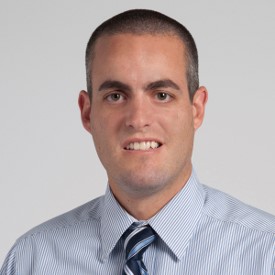The COVID-19 virus may be lingering on surfaces just waiting for the next person to touch and spread the infection.
Door knobs. Stair Rails. Countertops. Card readers. Some surfaces are touched by dozens, even hundreds of people every day, posing a public health risk in the midst of a pandemic.
A pair of Miami University scientists and their research teams are confronting this issue.
Rick Page, associate professor of chemistry and biochemistry, who studies protein chemistry and structural biology, and Dominik Konkolewicz, who studies synthetic macromolecules and polymer chemistry, have been conducting research together for about six years, looking for biomedical applications at the intersection of biological chemistry and synthetic chemistry. Now, their attention is focused on COVID-19.
Page and Konkolewicz are in the early stages of developing a film coating that could be applied to frequently touched surfaces that would disrupt and disable viruses that linger on the surfaces, including COVID-19 and other viruses like the common flu.
They recently received a grant from the National Science Foundation (NSF) worth about $180,000 to support the work.

Page said the product would work like a soap that doesn’t wash away or impede the use of surfaces. Konkolewicz said this is where a hardy polymer material, like a plastic coating, could be put to use. “How could we sort of have the same properties as soap but not make something that washes off,” Konkolewicz said. “That’s sort of where the polymer material comes in to give you that kind of durability… Generally, polymer materials are very durable with lifetimes of hundreds of years.”
Page said the polymer would incorporate similar chemical groups as soap, which interfere with the lipid bilayer — the outer protective shell — of the virus structure.
“The molecules in soaps basically break apart the lipid bilayer that surrounds that virus and that is highly effective at essentially killing the virus or inactivating it,” Page said. “And those sorts of groups are exactly what we’re looking to put into our material… Soap works really well but you can’t just apply soaps to a doorknob because it’s going to wear off, it’s going to transfer to people’s hands, it’s going to wash off if the surface gets wet… So it’s really about, ‘How do we take these compounds, these molecules that we know work very well for attacking and inactivating the virus, and how do we get them to be attached to the surface much more robustly so you have a material that you can use and you’re not going to have to reapply every time someone touches it.”

Konkolewicz said they’re designing the polymer to grab onto virus molecules by their glycoproteins — the spiky structures that coat the outside of the virus’s shell. “We’re looking at groups that would actually anchor those groups pretty strongly,” Konkolewicz said.
Once latched onto the virus, the soap-like qualities of the polymer would go to action.
“It’s almost like a mesh that’s over the surface,” Page said. “We have these groups that are sticking up and sticking out of it that are going to serve as the virus attachment sites and then others that are the ones that are actually going to attack the lipid bilayer.”
Page said the global effort against COVID-19 has put emphasis on the principles they study. “There was an opening that we saw that we could apply what we knew… to really try to make a positive difference,” Page said. “I’m really excited about the potential impact of what this could do.”
.jpg)
Konkolewicz said this project has added urgency, and their research groups were actually allowed back onto campus about 10 days earlier than other Miami research teams because the project was pertinent to COVID-19. “The urgency is just because of the nature of the problem,” Konkolewicz said. “Developing a solution in seven years doesn’t really help the urgency of the situation today.”
Konkolewicz and Page both said if they’re able to come up with a cost-effective design that would appeal to business, it would likely be licensed out to a company by the university since there wouldn’t be means to mass-produce a material such as this locally.
Page said the goal of making the public safer is aligned with the larger goals of their other research projects. “One of the things that’s really guided a lot of my research is how can we take our understanding and improved knowledge of what’s happening on the atomic level and how can we use that to improve human health,” Page said.
On June 19, the Ohio Department of Health announced that while COVID-19 cases have plateaued in most parts of Ohio, cases are on the rise in Southwest Ohio. As of July 1, Ohio has over 50,000 COVID-19 cases, with Butler Country now approaching 1,500 cases.
While many public spaces have now opened, some, including schools and day-care centers, remain closed. Research being done by scientists such as Page and Konkolewicz could eventually help make these places safer to the public.


